Final Exam Review PDF

| Title | Final Exam Review |
|---|---|
| Course | General Microbiology |
| Institution | Johnson & Wales University |
| Pages | 14 |
| File Size | 342.4 KB |
| File Type | |
| Total Downloads | 43 |
| Total Views | 146 |
Summary
Final exam study guide...
Description
Exam 1 -Spontaneous generation vs. biogenesis: ● spontaneous = belief that living things come from nonliving things ● biogenesis = living things only arise from living things -Pasteur’s swan neck flask experiment: disproved spontaneous generation Pasteur took a swan neck flask and sterilized nutrient broth in the flask, once the broth was sterilized, he inserted a tube which was curved at the end, and observed for new bacteria growth, and what he noticed was that the microbes would get trapped on the curve on the tube and the broth remain sterilized for weeks, since it was kept microbe free. This is how he proved that no non living thing can give rise to living things. -Overview of MICROBES (Chart drawn on board for living and non-living agents) ● Living - Bacteria and archaea which are prokaryotes (single celled organisms which lack nuclei and other membrane bound organelles) ○ Bacteria are known to cause human illness and these disease causing microbes are known as pathogens ○ Archaea- none of these organisms are known as pathogenic to humans ○ Eukaryotes- single or multicellular organisms; cells contain nuclei and other membrane bound organelles ■ four main types include: ● Animals- multicellular, heterotrophic, no cell wall present; some forms are microscopic ● Plants- multicellular, photosynthetic, cell walls contain cellulose ● Fungi- cell walls contain chitin - yeast- unicellular - mold- multicellular ● Protists- unicellular, heterotrophic or photosynthetic; cell wall may be absent or may contain cellulose or silica. ● Non Living ○ Viruses- obligate intracellular parasites ○ Prions-naked infectious proteins. -Handout comparing different types of microscopy (Focusing only on the key points that we discussed in class.) ● Microscope with multiple lenses = compound ● brightfield = darker image of specimen on brighter background ● darkfield = brighter image of specimen on darker background ● phase contrast = best for viewing live specimen ● fluorescent = UV light using fluorochrome stain ● TEM = electron beam to see structures WITHIN cells (only used on dead specimens) ● SEM = electron beam to see SURFACE detail (only used on dead specimens) -Overview of how the events in the history of microbiology have shaped the current field. Examples: ● Discovering of the fact that microbes are capable of fermentation led to our increased control over fermented products. ● Germ theory/Koch’s Postulates led to the idea that one microbe can cause one particular illness, and led to our capacity to track and address outbreaks of infectious diseases. ● Increased refinement of microscopy led to our capacity to investigate the forms and functions of various microbes. -Handout: Overview of Microbial Agents ● LUCA = last universal common ancestor; use RNA to trace sequences to Domain ● cells, certain organelles, and all major metabolic pathways evolved from early prokaryotic cells ● virus - no cell structure or wall; genome = DNA, RNA or both; replication requires infection of living cell ● prions - naked protein; no genome (no RNA/DNA); replication through re-folding model ● both viruses and prions are acellular with no cell structure or ribosomes ● prions cause mad cow disease (BSE) in cattle, and vCJD in humans
● ● ● ● ● ●
infectious dose = smallest amount of pathogen requires to cause a disease C. jejuni = prokaryotic & pathogenic T. gondii = protist & pathogenic S. cerevisiae = eukaryotic fungi (yeast); unicellular Yeasts & mold (multicellular) both contain chitin in cell walls Yeast performs fermentation (convert sugar to alcohol/gas & organic acids) norovirus
C. jejuni
T. gondii
S. cerevisiae
living/nonliving
nonliving
living
living
living
Euk/Prok
/
prok
euk
euk
Harmful/Helpful
harmful
harmful
harmful
helpful
Illness caused or how is it helpful
gastroenteritis
enteritis
toxoplasmosis
fermentation
-Handout: Bacteria and Archaeans Fundamentals ● Bacteria and archaeans are both unicellular and prokaryotic- they both lack nuclei and other membrane bound organelles. ○ One structural difference between the two is that when there is a cell wall in bacteria, it contains peptidoglycan. ○ Cell wall in archaea is known as pseudopeptidoglycan ○ Functionally bacteria are known to cause a variety of human pathogens ○ Archaeans on the other hand are not shown to cause any human pathogens ● Bacillus- rod shaped bacteria - Streptobacillus- chain like rod ● Cocci- sphere shaped bacteria - Staphylococcus- cluster like balls of bacteria - Streptococcus- chain sphere like balls of bacteria ● Spiral- spiral shaped or curved shaped bacteria - vibrio- fat curve - spirilium- thin curved bacteria - spirochete- is thread like bacteria (curved) ● Gram staining Step1: Primary StainCrystal Violet
Step 2: MordantIodine
Step 3- DecolorizerAlcohol/ Acetone
Step 4- Counterstainsafranin
Gram- Positive
Purple/ Violet
Purple
Purple
Purple
Gram- negative
Purple
Purple
White/ Clear
Pink - orange
-
The mechanism of penicillin is that it disrupts the synthesis of peptidoglycan chains in the cell walls and targets the synthesis Potential consequences of LPS in the body is that it is an endotoxin and can cause septic shock and death Gram negative Cells are more resistant to penicillin, antibiotics and disinfectants because they have an outer membrane which excludes and protects from certain antibiotics.
Exam 2 - Obj. #2: Compare and contrast the key structural and functional properties of prions, viruses, bacteria, archaeans, and eukaryotes. prion
virus
bacteria
archea
eukaryotes
living/nonliving
nonliving
nonliving
living
living
living
euk/prok
/
/
prok
prok
euk
harmful/helpful
harmful; infectious protein
harmful; intracellular parasite
many pathogenic
none are pathogenic
some pathogens
unicellular/multi
unicellular
unicellular
unicellular
unicellular
uni OR multicellular
nucleus/mem bound organelles
no
no
no
no
yes
ribosomes
none
none
70S
70S
80S
-Obj. #3: Explain how specialized structures (e.g. pili/fimbriae, capsules, or endospores) enable a microbe to survive in a given environment ● pili/fimbriae - adhere to host cell/resist removal ● capsules = easier to infect/adhere ● pilli transfer DNA ● endospore - dormant until favorable conditions -Material from 9/14 meeting; Handout on endospore formation (in Week 2 folder) ● Endospore formation is triggered by nutrient deprivation ● Three bacterial endospore formers associated with foodborne illness are: Clostridium Botulinum, Clostridium perfringens, and Bacillus cereus ● Clostridium tetani is an endospore forming bacterium, ○ Endospores found in dirt/dust/animal feces can enter a wound and cause tetanus ○ When endospores germinate to form vegetative cells in a puncture wound, they produce tetanospasmin, which is a powerful toxin that causes muscle spasms. ○ If not vaccinated against tetanus, these spasms can be so strong that they break bones and lead to respiratory death and failure ● Not all bacterial cells can form endospores ● If a bacterial cell can form an endospore it can survive under the following environmental conditions which might kill the vegetative cell but not the endospore ○ high temperature ○ radiation ○ desiccation ○ extreme pH ○ chemicals ● Endospore Structure: ○ The core is very dehydrated and contains DNA, ribosomes, and dipicolinic acid- promotes dormancy ○ The cortex aids in the spore’s heat resistance ○ The proteinaceous coat contributes to chemical resistance of the endospore ○ The germ cell wall will become the cell wall of the bacterial cell after the endospore germinates
Endospores are not metabolically active and they give rise to vegetative cells and hence can germinate and cannot produce toxins ● Vegetative cells can carry metabolic functions such as growth, cell division, metabolism etc. and they cannot germinate but produce toxins ● C. Botulinum spores will not germinate and grow in foods below pH 4.8. Some molds, however increase the pH of an acid food for this spore to grow. - Material from 9/21; Ppt slides in Wk 3 and Handout on protists, helminths, and fungi Protists: - Animal like: Protozoans - trophozoite- active feeding form of a protozoan - Cysts- protective, dormant structure formed by protozoans if nutrient abundance decreases - zoo plankton- animal-like part of the aquatic food chain; includes protozoans, microscopic invertabrates, and metazoans, these feed on phytoplankton - 4 levels of modes of motility: 1. Pseudopodia- for creeping engulfing prey such as amoeba - Pathogen: Entamoeba histolytica - eukaryotic parasitic amoeba; causes amoebic dysentery, also the 2nd leading cause of death from parasitic diseases worldwide . Causes gastroenteritis. 2. Flagella whip-like structures; PATHOGEN: Giardia lamblia - eukaryotic parasite; causes giardia “hiker's diarrhea”. Found in mountain lakes, streams. Causes nausea, cramping and diarrhea. 3. Cilia hair like structures that are shorter than flagella; present in gut of ruminants (eg: goats, cattle) 4. Non motile in adult stage: apicomplexans (complex of organelles at the cell’s apex or tip). Three examples of Pathogens are: - Plasmodium- transmitted by mosquito and causes malaria - Cryptosporidium parvum - eukaryotic protozoa; causes crypto- #1 waterborne disease in humans in US- caused by drinking and recreational water. Protective outer shell is chlorine resistant ; causes death in immunocompromised and children. - - Toxoplasma gondii- taxoplasmosis- causes flu like symptoms, and brain and eye damage in unborn babies. Transmitted via cat feces and via trophozoites in undercooked poultry - Plant like: Algae - Phytoplankton: form base of the aquatic food chain 1. Producers- Autotrophic-make their own food 2. The key organisms that make up phytoplankton are cyanobacteria and protists(green algae, diatoms and dinoflagellates) Dinoflagellates: type of organism associated with algal blooms such as red tide. 1. These organisms make toxins that kill fish or humans 2. Paralytic Shellfish Poison- not destroyed by cooking and does not change smell/ look of shellfish if present - Fungus like: Slime and water molds - Examples include: slime molds and water molds - One species causes downy mildew on grapes - Fungi: - eukaryotic, unicellular yeasts and multicellular molds - Yeasts- cell wall made of polysachharides and CHITIN - Molds and Mushrooms: consists of threadlike filaments called hyphae - The hyphae stretch into the growth medium and release enzymes like cellulase - to break down molecules in the environment and absorb nutrients - A tangled mass of hyphae is called a mycelium, and this structure is typically below the ground/growth surface. ●
A mold colony = a MYCELIUM (mat of hyphae) + reproductive structures (e.g. macroscopic mushrooms, which are like umbrellas, protecting spores.) - Yeast: Asexual, in a process called budding. Cell swells at one edge and a new cell, called a blastospore buds from the parent cell. When the blastospore detaches from the parent cell, it leaves a scar behind. - Molds: Spore production, known as sporulation . Asexual spores formed by mitosis, while sexual spores form by meiosis. - Sexual - mitosis and meiosis become evolutionary species - Asexual- budding or binary fission - Fungi are classified based on reproductive structures - Phylum ZYGOmycota: -Asexual spores formed AND sexual reproduction leads to formation of a hardy ZYGO SPORES, which can give rise to a fruiting body that releases sexual spores. -Zygomycota includes fast-growing RED molds, and those that grow on fruit with high sugar content and acidic vegetables. Some species used to make sake (from rice) and tempeh (from soybeans). - -Phylum ASCOmycota (largest phylum): -Form an ASCUS (small spore-containing sac) during the lifecycle. The asci hold ASCO spores. -Includes plant parasites (including chestnut blight disease); Most are molds (with hyphae and mycelium), but a few are single-celled yeasts, including those used in baking and fermentation. -Includes sought-after morels and truffles -Includes Penicillium species, used to make penicillin and to flavor Roquefort and Camembert. -Includes Aspergillus oryzae (called Koji in Japan), used to produce citric acid, soy sauce, and vinegar. -Includes Aspergillus flavus, which produces AFLATOXINS in contaminated nuts and grains. These toxins are powerful cancer-causing agents (carcinogens) that target the liver. - -Phylum BASIDIOmycota: -Form BASIDIOspores. -Includes gill fungi (commonly called white buttons). Mushrooms are actually sporeforming fruiting bodies made of hyphae. These structures arise from underground mycelia. Name of store-bought white mushroom: agaticus bisporus; - Amanita phalloides is known as the “death cap.” (ingestion of these causes up to 90% of mushroom poisoning deaths worldwide. Easily mistaken for non-poisonous, since not very distinct in look/taste/smell.) -Includes some plant parasites and corn smut - Mutualistic relationships between fungi and plants: - Mycorrhizae grow on the roots of some trees, flowers, and shrubs, and provide these plants with additional nutrients. -Endophytes tend to grow in plant leaves, and protect the plant from stressful conditions. - yeasts used in fermentation reactions: -Saccharomyces cerevisiae is used in bread baking and alcohol production. -
-Saccharomyces ellipsoideus and many other variants/strains of S. cerevisiae is used in alcohol production. -For beer brewing: There are MANY strains of S. cerevisiae used. Some known as TOP yeast, used to make ALE, and some BOTTOM yeasts, used to make LAGAR. -Fermentation byproducts are CO2 and Ethanol. -What causes bread dough to rise? : CO2 - PARASITIC HELMINTHS: Eukaryotic animals (with organs and organ systems…but studied in microbio because often identified by microscopic eggs and larvae).
-
Phylum Nematoda (roundworms): -Includes Trichinella spiralis, which can infect humans via undercooked meat.
-
Phylum Platyhelminthes (flatworms): -Includes Schistosoma, which causes schistosomiasis—a major disease burden in humans -Includes tapeworms Plasmodium: malaria Entamoeba Histolytica: amoebic dysentery Giardia Lambdia: hiker’s diarrhea Cryptosporidium Parvum: cryptosporidiosis (“crypto”) Toxoplasma gondii: toxoplasmosis (“toxo”) Dinoflagellates: type of organism that can, in some cases, produce PSP (paralytic shellfish poison) Aspergillus flavus: type of fungus that produces AFLATOXIN (a potent liver carcinogen) Schistosoma: schistosomiasis
- All vocab words from the handout EXCEPT the fungal phyla (e.g. Basidiomycota); You do NOT need to memorize these names for how different fungi are classified and you do NOT need to memorize what kind of fungus falls into which phylum. Just know that fungi are classified based on their reproductive structures/mechanisms. - Organisms to know by name (and type (e.g. eukaryotic and protist or helminth or fungus): ● Entamoeba histolytica - eukaryotic parasitic amoeba; causes amoebic dysentery ● Giardia lamblia - eukaryotic parasite; causes giardia “hiker's diarrhea” ● Cryptosporidium parvum - eukaryotic protozoa; causes crypto ● Toxoplasma gondii - eukaryotic unicellular protozoa; causes toxoplasmosis ● dinoflagellates - eukaryotic protist; produces PSP (paralytic shellfish poisoning) ● Aspergillus flavus - eukaryotic fungus; produces aflatoxin -Material from 9/26 meeting; Handout on viruses and prions in the Week 4 folder ● viral genome: composed of either DNA or RNA & single or double stranded; virus genetic material ● capsid: protein coated layer of a virus that surrounds it ● capsomere: subunit of capsid; made of 1 or more types of capsomere proteins inside capsid ● nucleocapsid: capsid of virus w/ enclosed nucleic acid (genetic material) ● envelope: part of phospholipid membrane from host cell; only in viruses w/ nucleic acid surrounded by lipid layer ● obligate intracellular parasites: (eg virus) can only replicate by infecting living cell ● oncovirus: cancer-causing virus ● lytic cycle stage: 1. attachment - phage attach to surface of host cell 2. penetration - viral DNA enters host cell 3. biosynthesis - phage DNA replication & phage protein made 4. maturation - new phage particles assembled 5. lysis - cell lyses & releases new phages ● norovirus - extremely contagious; transmitted person to person, food (eg. raspberries & oysters), water; leading cause foodborne disease outbreaks in US (35%); causes gastroenteritis ● hepatitis A - acute illness (rapid onset); incubation 15-50 days (time it take for symptoms to show); decreased instances after vaccine created ● PrPSc - abnormally folded prion protein, scrapie associated; fatal prion disease resulting in neuro dysfunction; humans get CJD, cows get BSE; 7-13 yr incubation period ● transmissible: ability to spread from 1 organism to another
-Material from 9/28;Microbial Biochemistry and Unknown Identification. LIMITED to the questions presented in Quiz 6! ● Characteristic/compound NOT considered to be a phenotypic biochemical characteristic for microbial ID: small subunit (16s) rRNA gene ● Phenotypic biochemical characteristics used for microbial identification include contents of storage granules, carbon utilization, and lipid composition. Sequencing of DNA or rRNA is not phenotypic but genotypic characterization. ● Method that involves analysis of membrane-bound carbohydrates: lancefield group testing ● Lancefield group testing characterizes the membrane-bound carbohydrates on certain types of cells (and is use for classification of Streptococci). ● Method involves conversion of microbe’s lipid to volatile compounds for analysis by gas chromatography: FAME ● FAME is the method that converts a microbe’s lipids to volatile compounds for analysis by gas chromatography ● Denaturation implies loss of the secondary and tertiary structures w/o loss of the primary structure ● MALDI-TOF is a method that makes ions (charged particles) out of a microbe’s molecular components, and then analyzes them using mass spectrometry. Exam 3 (ch 8-11) - Obj. #4: Describe how the metabolic characteristics of microorganisms influence their intercellular interactions, their interactions with their environments, and their survival and growth in a given environment. ● metabolism: chemical interactions inside a cell ● prefix: auto- (self); hetero- (other) = carbon source ● enzymes: catalyst for biochem rxns in cells; influenced by environment & substrate concentration ● anabolic: small molecules -> larger (use energy) ● catabolic: large broken down to small (release energy) - Beginning of Obj. #5: Describe how mutations and…
- Obj. #11: Provide examples of how humans rely on and utilize microbes and their products, e.g…..food/beverages, industrial products etc. ● alcohol fermentation -> bread ● mixed acid fermentation -> pharmaceuticals ● propionic acid fermentation -> swiss cheese ● lactic acid fermentation -> yogurt ● acetone-butanol-ethanol fermentation -> industrial solvents ● microbe responsible for ethanol fermentation for alcoholic beverages: saccharomyces
- Material from 10/3; 3 handouts on microbial metabolism (fermentation products in foods/beverages) & growth Name of stage
Net # ATP molecules produced
glycolysis
2
krebs cycle (citric acid c...
Similar Free PDFs

Chem Final Exam Review
- 12 Pages

Final Exam - Review notes
- 92 Pages

Bio Final Exam Review
- 2 Pages

Final EXAM Review booklet
- 5 Pages
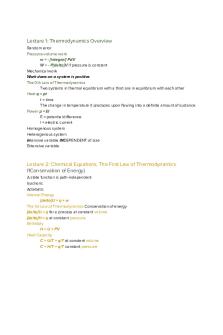
CHEM303 final exam review
- 4 Pages

Psychology Final Exam - Review
- 13 Pages
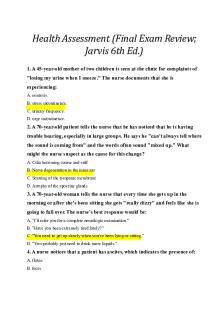
Jarvis Final Exam Review
- 12 Pages
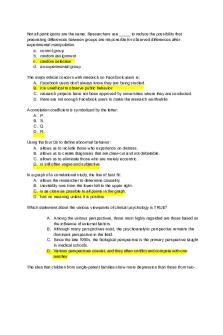
Final exam review
- 96 Pages
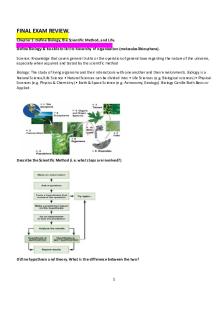
Final Exam Review
- 48 Pages
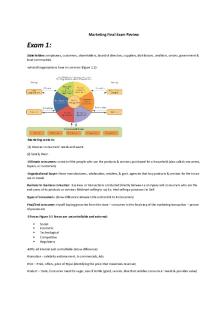
Marketing Final Exam Review
- 15 Pages
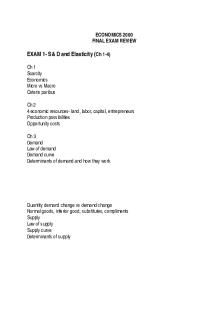
Final exam review
- 8 Pages
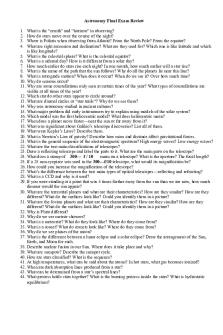
Astronomy Final Exam Review
- 2 Pages
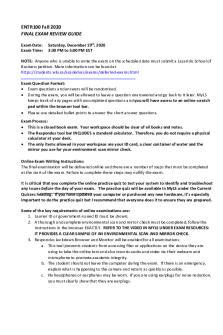
Final Exam Review Guide
- 4 Pages

Final exam review flsp4420
- 5 Pages

Theo Final Exam Review
- 16 Pages

Entrepreneurship final exam review
- 33 Pages
Popular Institutions
- Tinajero National High School - Annex
- Politeknik Caltex Riau
- Yokohama City University
- SGT University
- University of Al-Qadisiyah
- Divine Word College of Vigan
- Techniek College Rotterdam
- Universidade de Santiago
- Universiti Teknologi MARA Cawangan Johor Kampus Pasir Gudang
- Poltekkes Kemenkes Yogyakarta
- Baguio City National High School
- Colegio san marcos
- preparatoria uno
- Centro de Bachillerato Tecnológico Industrial y de Servicios No. 107
- Dalian Maritime University
- Quang Trung Secondary School
- Colegio Tecnológico en Informática
- Corporación Regional de Educación Superior
- Grupo CEDVA
- Dar Al Uloom University
- Centro de Estudios Preuniversitarios de la Universidad Nacional de Ingeniería
- 上智大学
- Aakash International School, Nuna Majara
- San Felipe Neri Catholic School
- Kang Chiao International School - New Taipei City
- Misamis Occidental National High School
- Institución Educativa Escuela Normal Juan Ladrilleros
- Kolehiyo ng Pantukan
- Batanes State College
- Instituto Continental
- Sekolah Menengah Kejuruan Kesehatan Kaltara (Tarakan)
- Colegio de La Inmaculada Concepcion - Cebu